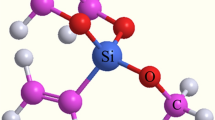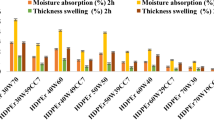Abstract
The effects of wood fiber/cement ratio, water/cement ratio and carbon dioxide injection time on the carbonation reaction and strength of wood-cement composites were evaluated. Increasing fiber content usually led to stronger composites and lower carbonation degree while increasing water amount decreased strength of composites in most cases. Either insufficient water or excessive water reduced carbonation reaction rate. There was a significant interaction effect between fiber content and water content, which had to be considered in optimizing the variables. Prolonging carbon dioxide injection time gradually increased carbonation degree, but did not affect the ultimate strength of composites.
Process optimization was conducted according to the effects of the considered variables on the strength of composites. The validation experiment confirmed that the estimated optimal strength could be approximately obtained. Carbonated wood-cement composites performed much better than uncarbonated ones in conventional and accelerated ageing tests.
Zusammenfassung
Der Einfluss der Holzfaser/Zement- und Wasser/Zement-Verhältnisse sowie der Dauer einer Kohlenstoffdioxid-Begasung auf die Karbonisierungsreaktion und die Festigkeit von Holz-Zement-Werkstoffen wurden untersucht. In der Regel führte ein höherer Fasergehalt zu Werkstoffen mit einer höheren Festigkeit und einem niedrigeren Karbonisierungsgrad, wohingegen ein höherer Wassergehalt in den meisten Fällen die Festigkeit der Werkstoffe reduzierte. Zu wenig oder zu viel Wasser verlangsamten die Karbonisierungsreaktion. Es wurde eine erhebliche Wechselwirkung zwischen Faser- und Wassergehalt festgestellt, die bei der Optimierung der Variablen beachtet werden musste. Eine längere Kohlenstoffdioxid-Begasungsdauer erhöhte den Karbonisierungsgrad, wirkte sich auf die Festigkeit der Werkstoffe jedoch nicht aus.
Die Prozessoptimierung wurde im Hinblick auf die Wirkung der betrachteten Variablen auf die Festigkeit der Werkstoffe durchgeführt. In einem Überprüfungsversuch wurde die geschätzte optimale Festigkeit näherungsweise erreicht. Karbonisierte Holz-Zement-Werkstoffe erzielten in konventionellen und beschleunigten Alterungsprüfungen wesentlich bessere Ergebnisse als nicht karbonisierte Werkstoffe.
Similar content being viewed by others
References
American Society for Testing and Materials (2003) ASTM C496-96, Standard test method for splitting tensile strength of cylindrical concrete specimens. West Conshohocken, Pennsylvania, USA
Geimer LR, Leao A, Armbruster D, Pablo A (1994) Property enhancement of wood composites using gas injection. In: Maloney M (ed) Proceedings of the 28th Washington State University international particleboard/composite materials symposium. Pullman, WA, USA, pp 243–259
Geimer LR, Souza MR, Moslemi AA (1996) Low-density cement-bonded wood composites made conventionally and with carbon dioxide injection. Drvna Ind 47(2):55–62
Geimer RL, Souza MR, Moslemi AA, Simatupang MH (1992) Carbon dioxide application for the production of cement particleboard. In: Moslemi AA (ed) Proceedings: Inorganic-Bonded Wood and Fiber Composite Materials. For Prod Soc, Madison, WI, USA, pp 31–41
Matsushita F, Aono Y, Shibata S (2000) Carbonation degree of autoclaved aerated concrete. Cement Concrete Res 30(11):1741–1745
Moslemi AA, Souza M, Geimer R (1994) Accelerated ageing of cement-bonded particleboard. In: Moslemi AA (ed) Proceedings, Inorganic-Bonded Wood and Fiber Composite Materials, Forest Products Society, Madison, WI, USA, pp 83-88
Neville AM (1995) Properties of concrete. Longman Group Limited, New York, USA
Onwubiko C (2000) Introduction to engineering design optimization. Prentice Hall Inc., Upper Saddle River, NJ, USA
Pablo A, Geimer RL, Wood Jr JE (1994) Accelerated pressing of low-density cement-bonded board. In: Moslemi AA (ed) Proceedings, Inorganic-Bonded Wood and Fiber Composite Materials. For Prod Soc, Madison, WI, USA, pp 98–102
Pearce WR (2003). Mill test report – CSA A5 Type 10. St. Marys Cement Inc., St. Marys, Ontario, Canada
Qi H, Cooper PA, Wan H (2006) Effect of carbon dioxide injection on production of wood cement composites from waste medium density fiberboard (MDF). Waste Manage 26(5):509–515
Simatupang MH (1979) The water requirement in production of cement-bonded wood particleboard. Holz Roh- Werkst 37(10):379–382
Simatupang MH, Habighorst C, Lange H, Neubauer A (1995) Investigation on the influence of the addition of carbon dioxide on the production and properties of rapidly set wood-cement composites. Cement Concrete Compos 17:187–197
Vanderplaats GN (2001) Numerical optimization techniques for engineering design. 3rd edition, 4th printing. Vanderplaats Research & Development Inc., Colorado Springs, CO, USA
Author information
Authors and Affiliations
Corresponding author
Rights and permissions
About this article
Cite this article
Qi, H., Cooper, P.A. The effects of composition and carbon dioxide injection time on the properties of wood-cement composites . Holz Roh Werkst 65, 267–273 (2007). https://doi.org/10.1007/s00107-006-0155-3
Published:
Issue Date:
DOI: https://doi.org/10.1007/s00107-006-0155-3




